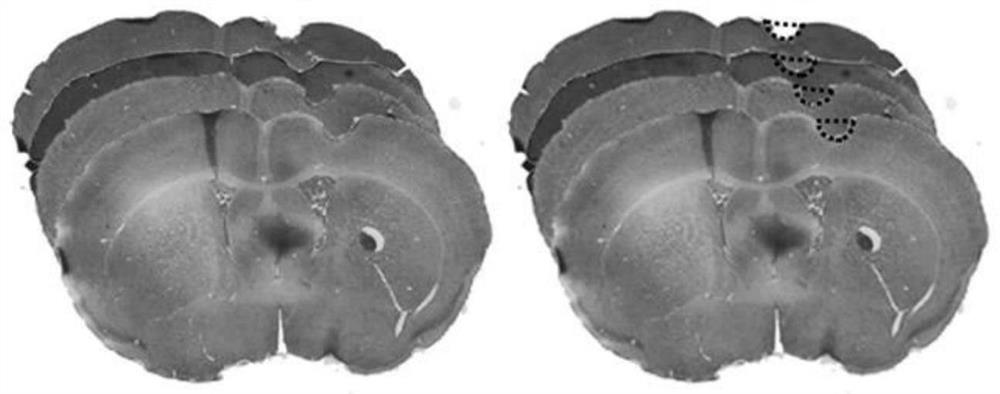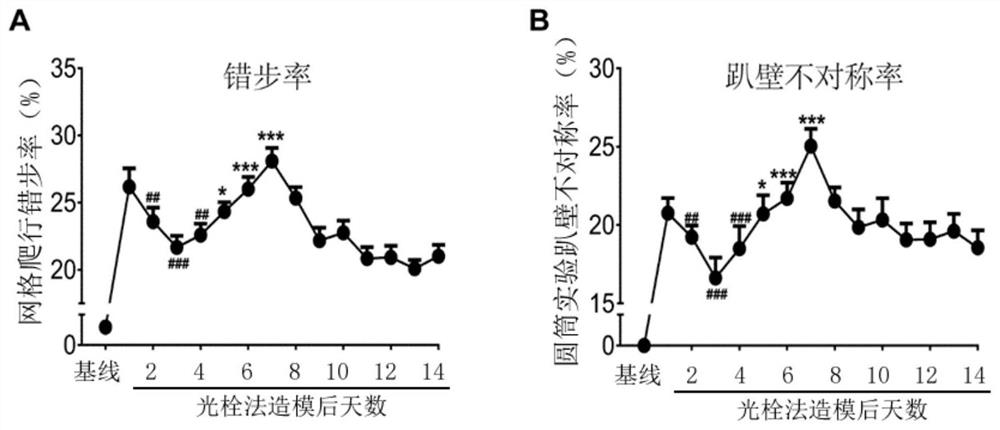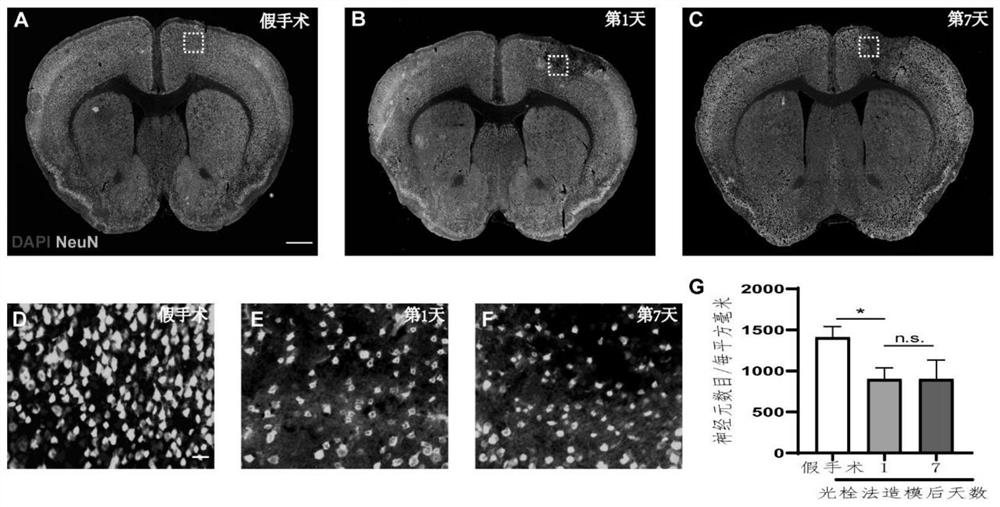Construction method of progressive cerebral arterial thrombosis model
A technology of ischemic stroke and construction method, which is applied in animal husbandry and other fields, can solve the problems of inability to accurately reflect the characteristics of pathological changes in progressive stroke, inability to directly apply research, secondary deterioration, etc.
- Summary
- Abstract
- Description
- Claims
- Application Information
AI Technical Summary
Problems solved by technology
Method used
Image
Examples
Embodiment 1
[0030] Example 1: Construction of a mouse model of progressive ischemic stroke induced by photochemical embolization
[0031] (1) Choose C57BL / 6J wild-type male mice aged 10-12 weeks and weighing 23-25 g, and maintain anesthesia with sevoflurane gas;
[0032] (2) Fix the head of the mouse on the stereotaxic instrument, remove the head hair and disinfect the surface, cut the skin through the median incision, expose the bregma, and fix an optical fiber with a diameter of 2.0mm close to the top of the skull;
[0033] (3) The light emitting diameter of the cold light source is 2.0mm, and the light source is vertically attached to the top of the skull, and the center of the light source is shifted to the right by 1.5mm compared with the brine;
[0034] (4) Rose Bengal was injected intraperitoneally at a dose of 100 mg / kg, and then irradiated with a cold light source for 15 minutes after 5 minutes, and the intensity of the cold light source was 16000 lux;
[0035] (5) After the i...
Embodiment 2
[0040] Example 2: Progression of neurological deficits within 14 days after progressive ischemic stroke mice were modeled
[0041] Mouse Stagger Test:
[0042] The mice were placed on a grid with a side length of 40 cm and an inner 1 cm square, the grid was made of iron wire with a diameter of 1 mm, and the height from the ground was 30 cm. A camera is set at the bottom of the grid to record the free movement of the mouse on the grid. When a normal mouse moves freely, both front and rear feet step on the wire. Due to the influence of cerebral ischemia, the front and rear feet on the opposite side of the ischemic brain step on the empty grid. Every missed step is counted as a wrong step. Take pictures of the total number of 100 steps of the mouse's free activities, record the number of wrong steps and calculate the wrong step rate ( figure 2 A).
[0043] Cylinder test:
[0044] Put the mice in a transparent cylinder with a diameter of 10 cm and a height of 15 cm, and place...
Embodiment 3
[0047] Example 3: Progressive ischemic stroke in mice without increased neuronal loss
[0048] Immunohistofluorescence staining:
[0049] First, slides were permeabilized with pre-cooled methanol at -20°C for 15 min. Rinse twice with 1×PBS at room temperature, 5 min each time. Block with blocking solution (PBS+2.5% donkey serum / goat serum, 0.2% Triton X-100) for 1 h at room temperature. Dilute the specific primary antibody (1:200) in blocking solution and incubate overnight at 4°C. On the next day, rewarm on a shaker for half an hour, rinse 3 times with 1×PBS for 10 minutes each time, add the corresponding secondary antibody (1:400) in a dark environment and incubate at room temperature for 1-2 hours. Then, rinse 3 times with 1×PBS, 10min each time. Mount the slides with DAPI-containing mounting solution, cover the coverslip without generating any air bubbles, and seal the edges with transparent nail polish. Store at 4°C in the dark, and observe with an inverted confocal ...
PUM
| Property | Measurement | Unit |
|---|---|---|
| Diameter | aaaaa | aaaaa |
| Diameter | aaaaa | aaaaa |
| Thickness | aaaaa | aaaaa |
Abstract
Description
Claims
Application Information
 Login to View More
Login to View More - R&D
- Intellectual Property
- Life Sciences
- Materials
- Tech Scout
- Unparalleled Data Quality
- Higher Quality Content
- 60% Fewer Hallucinations
Browse by: Latest US Patents, China's latest patents, Technical Efficacy Thesaurus, Application Domain, Technology Topic, Popular Technical Reports.
© 2025 PatSnap. All rights reserved.Legal|Privacy policy|Modern Slavery Act Transparency Statement|Sitemap|About US| Contact US: help@patsnap.com



